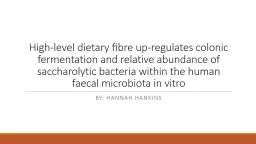

upregulates colonic fermentation and relative abundance of saccharolytic bacteria within the human faecal microbiota in vitro By Hannah hankins Large Intestines Microbiota and Fiber ID: 777379
Download The PPT/PDF document "High-level dietary fibre" is the property of its rightful owner. Permission is granted to download and print the materials on this web site for personal, non-commercial use only, and to display it on your personal computer provided you do not modify the materials and that you retain all copyright notices contained in the materials. By downloading content from our website, you accept the terms of this agreement.
Slide1
High-level dietary fibre up-regulates colonic fermentation and relative abundance of saccharolytic bacteria within the human faecal microbiota in vitro
By: Hannah
hankins
Slide2Large Intestines, Microbiota, and Fiber
Large intestines/Colon: Last part of the Digestive System. Responsible for removing the remaining water and nutrients from food before it is excreted. Absorb vitamins created by colonic bacteria
Gut Microbiota: microscopic organisms living in the gut. About 10^11-10^12 bacteria in the colon. They compose up to 60% of your feces.
Fiber: fiber is the edible parts of plants or analogous carbohydrates that are resistant to digestion and absorption in the human small
intestine
.
Slide3FiberDietary fiber is suggested to impact human energy metabolism in a number of ways including:regulation of intestinal transit time,
digestive function through bulking and gel-form activities
r
educing energy density of foods
acti
ng as a substrate for carbohydrate fermentation by the colonic microbiota. Carbohydrate fermentation results in the production of short chain fatty acids:
Acetate, propionate, and butyrateHelp regulates lipogenesis, act as an energy source for the gut, regulate gut hormones, and impact fat storage.
Certain types of dietary fiber like oligosaccharides, inulin, fructo
-oligosaccharides and
galacto
-oligosaccharides induce bifidogenic effects within human
faecal
microbiota.
Slide4Microbiota and HealthThe intestinal microbiota has been linked to the aetiology or maintenance of many chronic diseases.
Bowel disease
Colon cancer
Diseases associated with obesity.
Increasing production of beneficial bacteria like
bifidobacterium
and lactobacillus may increase immunity, vitamin production, and inhibit pathogens.
Slide5Objectives and HypothesisPast study done in rural Africa found that children who consumed plant based diets rich in different types of fiber had a distinct microbiota composition, mainly
saccharolytic
bacteria. Found three times the amount of SCFA in the
faeces
of the
the Africans compared to a European diet.8grams
see the
impact of increasing total dietary
fibre
by
threefold (3x the normal western diet)
on the composition and metabolic activities of human gut
microbiota.
Use an
in vitro (non-living) three stage continuous culture system to mimic the colon and simulate the effects of different amounts fiber on the gut.
Slide6Vessel 1
280 mL
Vessel 2
300 mL
Vessel 3
300 mL
Proximal Colon
Transverse Colon
Distal Colon
pH 5.5
pH 6.8
pH 6.2
Culture Medium: Designed to mimic the most common western-style diet in the UK.
RESAZURIN: Indicator of
anaerobicity
Nitrogen
Nitrogen
Nitrogen
Nitrogen Free gas pumped in to maintain anaerobic conditions
Used a
FerMac
pH controller to pump
HCl
ans
NaOH
to maintain
pH.
Slide7Inoculated with 100ml of 20% Faecal
Inocula
(2 males and 1 female)and pre-reduced PBS.
Fermented in three phases (Steady States). Retention time was 36 hours long.
1. Gut Models were fed with a standard medium with initial level of dietary
fibre
content.2. The level of fiber was increased three-fold with starch, inulin, guar gum,
xylan, pectin, and arabinogalactin.
3. Level of fiber reduced and allowed back to normal.
Samples were taken for four consecutive days for bacterial and short chain fatty acids analysis.
Methods
Slide8AnalysisAnalysis used: FISH, SCFA via GC, PCR-DGGE, and statistical analysis of bacteria count. FISHOligonucleotide probe to recognize certain microbiota
5890 Series GC
system
calculated Short Chain Fatty acids from culture.
PCR-DGGE
PCR: amplifies replication of specific segments of DNA based on primers applies DGGE: Denaturing Gradient Gel Electrophoresis- banding patterns can be used to visualize variations in microbial genetic diversity
Slide9Results
FISH analysis shows the mean changes in bacterial changes.
5890 Series GC system to show changes in SCFA production
Slide10Results
banding patterns
show variations
in microbial genetic
diversity.
More/thicker bands show more diversity/presence of microbiota
Slide11Binary Data Matrix and PCA
Generated by the presence or absence of DGGE bands
Red-Steady State 1
green- Steady State 2
black- Steady State 3
Slide12DiscussionUpon the high fiber supplementation there was a relative abundance of:Bifidobacterium (p<0.05)
Associated
with improved biomarkers of CVD and colon cancer.
Eubacterium
rectale-clostridium coccoidesfaecalibacterium prausnitzii
(p<0.05) proximal colon (vessel 1)Produce a majority of butyrate in the colon. faecalibacterium prausnitzii aids in maintaining colonic health and reducing chances of inflammatory bowel diseases. Helps with the secretion of metabolites able to block NF-
kB and IL-8 production.Lactobacillus/enterococcus (p<0.05)Ruminococcus
(
p<0.05)
Adheres
to starch particles and digests cellulose
Carbohydrate rich environment increased the growth of this bacterium.
Implies the bacteria is sensitive to modulation created by starch/carbohydrate-rich diets.
Slide13Possible future studies and limitations of this studySince the study is In vitro, it lacks: - human cell or immune interactions- no capacity to mimic absorption of organic acids and other microbiota metabolites or conversely,
- hosts secretions and water absorption.
It has a small sample size (2 males and one female)
FUTURE STUDIES: How different
enterotypes
respond to high fiber availability
Slide14ConclusionMixed fiber consumption intake has a beneficial effects on the human gut microbiota composition.
Continuous consumption of large quantities of high fiber foods can improve colonic health and overall well being.
Slide15What to Take From This
FIBER IS YOUR FRIEND!!!
DON’T BE AFRAID TO MIX IT UP A BIT!
Slide16END
Slide17SFCAACETATEActs as a substrate for hepatic de novo lipogenesis
via
acetyle-coa
and fatty acid synthase
BUTYRATE
butyrate is a major energy source for colonic mucosa. May enhance adaptive thermogenesis thus increasing energy expenditure to control body weight and markers of metabolic syndrome.
Slide18propionatePropionate down-regulates lipogenesis-reduced expression of fatty acid synthase